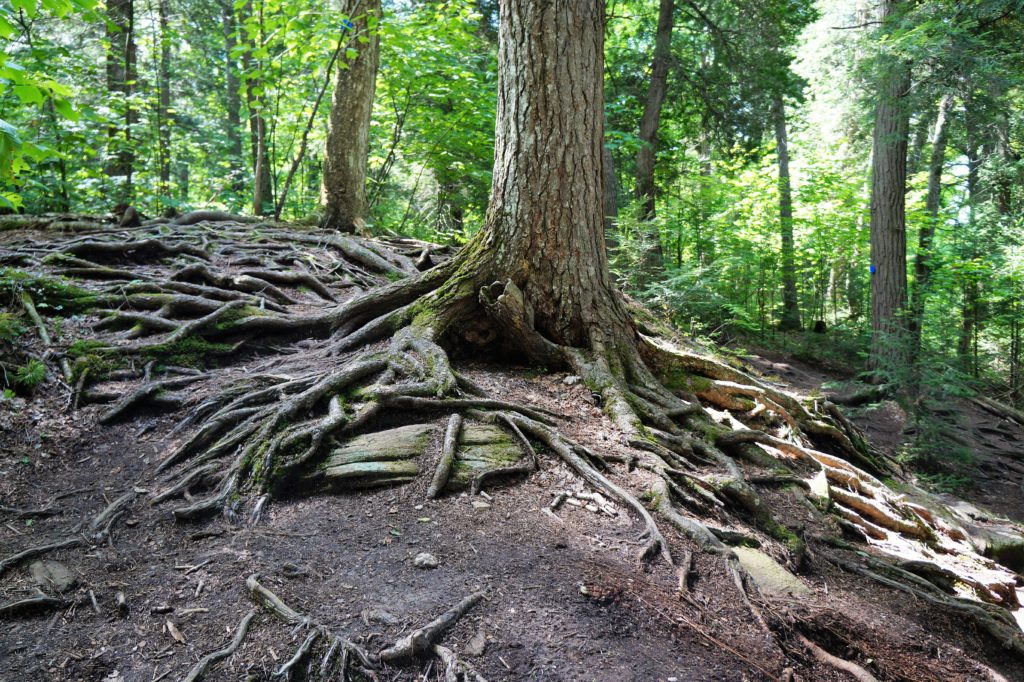How our forests influence water flow in Muskoka
by Javier Cappella.

Water and forests in Muskoka’s watersheds are intimately linked. Muskoka’s forests are unique in their abundance. Without the intense land use pressures of southern Ontario but still far enough south to have a diverse number of tree species, the forests here are the main terrestrial use of land. Most of the rain and snow that falls on land makes its way to our lakes, rivers and streams through the forest. Forests have a huge impact on the water cycle in our watersheds, and the two are interdependent.
Rain and snow are the inputs of water into the forest. Rain is moisture that trees can absorb right away while snow is moisture held in reserve and used as it melts in the spring. Evapotranspiration and runoff are the outputs of water out of the forest. Evapotranspiration is simply the total sum of moisture from the forest to the atmosphere by evaporation of water from the soil and transpiration (think sweating through their leaves) from trees. Evapotranspiration helps to form clouds and precipitation. Runoff is water that moves across the forest floor or in the soil as groundwater, making its way down hill, to streams and lakes. Runoff enables forests to filter and regulate the flow of water across land.
Soil controls the movement of water in our forests. Soil is the main storage reservoir in forests and acts like a bucket that is filled by rain and emptied by evapotranspiration and runoff. How much water can be stored by the soil depends on the size of the bucket. Muskoka’s thin soils over bedrock act like shallow buckets that can hold only a small amount of water. Fine textured soils like clay hold more water then coarse textured soils like sand. When the capacity of the soil to hold water is reached then, just like water spilling over the edge of a bucket, water moves into streams and lakes as runoff.
Trees play an important role in slowing down the movement of water from the atmosphere to the soil. The canopy of the forest intercepts a substantial proportion of the precipitation. Trees can intercept from 10-50% of the water in one rain event. After a light rain or snowfall, it is possible that most of that water may evaporate directly to the atmosphere without ever reaching the forest floor.
The majority of water that falls as precipitation does make its way to the forest floor and some of this water makes its way along the stems of the trees. The architecture of the tree influences how much water runs down its stem. A vase shaped tree like a sugar maple will direct water towards itself while a triangular shaped tree like a white spruce will direct water away from its stem. The texture of the bark influences the direction and velocity of water moving along the stem of a tree. Smooth barked trees like American beech have greater stem flow then rough-barked trees like white ash.
Stem flow is important in forests because this water takes the express lane down the tree and into the soil through the channels created by the roots. This can provide an even distribution of water to the roots and fill the soil bucket from the bottom up reducing the amount of surface water runoff.
When planning developments on “tablelands” which remove forests, it is important to consider the ecosystem services that forests provide. Forests work to control the amount and quality of water in our lakes, rivers and streams. Individual trees play an important role in the rate and amount of flow of water through the forest and through the remainder of the watershed.
Javier Cappella is a Registered Professional Forester (R.P.F.) with Westwind Forest Stewardship Inc. and a member of the Muskoka Watershed Council.
